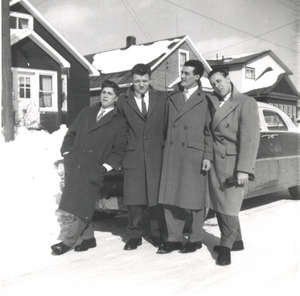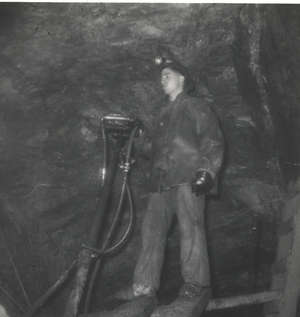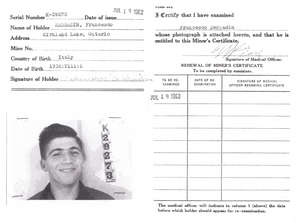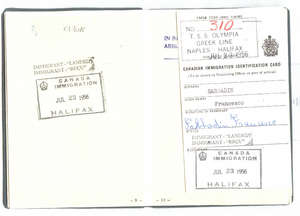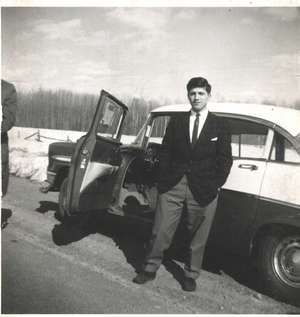Sobey Wall of Honour
Column
62
Row
7
I was 19 years old when I left "Italia" from the port of Napoli on July 15,1956. Why I left my country of birth? It all began in 1942 when my father and mother died within 15 days of each other. They left 7 of us. Four boys and three girls, the oldest was 12 years olf and the youngest was 4 years old. My early years were spent going from the orphanage to work on the family farm when I was 6 years old to 19 years old. There are many stories to be told from this period in my life.
We owe our life to two aunts on my father's side. They provided for us and kept us together as a family. This was 1942 part of the last 3 years of World War II, very hard times for us kids. We had no future, with the small farm and lack of jobs. At this point my aunt received a letter from a cousin in Northern Ontario, Canada.
She was told that the gold mines of Kirkland Lake and vicinity, in cooperation with the Canadian Government, were sending a representative to recruit young workers from the Castelfranco - Veneto area, in the province of Treviso in Northern Italy. The name of the representative was Leone Bernardo. I went to see him as soon as he arrived and his first comments was that I am too young and too skinny. But as I explained my family situation to him, he agreed to fill in an application form with an "exception". In four to five weeks we will meet with the Canadian Consulate Representative and it will be up to them to give the ok.
Those five weeks were the longest five weeks of my life. Finally when the day arrived, Mr. Bernardi came by my house to pick me up and took my to the Canadian Consulate in Castelfranco - Veneto. When they called my name, Mr. Bernardi and I went up to the desk and even before they asked me any questions, Mr. Bernardi explained my family situation to the Consulate representative. He gave me a long look and said he needs no consideration. When he stamped my Visa, I knew I was accepted. Mr Bernardi was the translator from English to Italian, for all us that day. There was from 30 to 40 guys from my hometown of Poggiana Di Riese as we travelled by train to Napoli, where we boarded the Greek Liner Olympia on July 15, 1956 bound for Canada.
My crossing of the ocean, it was a sad story. I was sea-sick most of the way and did not see much of the deck. The TSS Olympia landed at Pier 21 in Halifax, Canada on July 23, 1956. As I remember, there was chain link fence that divided the Pier into corridors and rooms and we all had tags with big numbers. We were part of a special group. Mr. Bernardi had all our paperwork ready. Now here we were in Canada with chain link fence surrounding us and we didn't understand the language; it was horrible. Fortunately, we didn't stay long at Pier 21. Mr. Bernardi, with an escort from port security, made us walk 10 to 15 minutes to a train station to Kirkland Lake, Ontario.
The train ride was indescribable. The passenger cars had wooden benches and we rode the train for days and days. You could not rest or even sleep, and the food, those sandwiches - we drank a lot of water. Some of us thought that we would never make it to the gold mine. Mr. Bernardi was again doing all kinds of paperwork and he kept reassuring us that it would not be long. Finally the train stopped. Mr. Bernardi told us that this was our stop. We were stunned by the name of the town, "Swastika", as we thought our destination was to be Kirkland Lake. But, Mr. Bernardi reassurred us that it was only a short bus ride to Kirkland Lake. Finally, after a 15 minute bus ride, in the mid morning of July 26, 1956 we arrived in Kirkland Lake.
We were all surprised to see that the houses, buildings and walkways were mostly made of wood. As we asked about the wood, we were told that having such long and cold winters, wood is much warmer and easier to work with.
I started to work the very next morning, the 7 o'clock to 3pm shift. We were all put up in rooming and boarding houses. My breakfast that morning was scrambled eggs, bacon and toast with ketchup and mustard. The only thing I could eat was the toast because when I saw the fellow next to me put ketchup all over his eggs, I could not eat my breakfast. It was a short walk to the mine on my first day. There were 7 of us and we were introduced to the other members of the crew.
My two companions were an Englishman named Jim Smith and a Yugoslavian named Mike Zawaly. Mike spoke enough Italian for me to understand. From the office we would walk to Building A, called the "dry." Inside there is nothing but benches and chains with steel baskets. Mike pointed to a chain with a number 37 on it, "This is assigned to you," he said. We leave our clean clothes here then we walk to the next building, Building B. There we go to our assigned chain and basket where we find our working clothes. Now I am ready to go to work. I have my working clothes on, plus rubber gloves, pants and jacket, safety boots and helmet with a battery operated light.
We walked over to the Shaft House, where there were these big winches and many different noises I have never heard before. Mike said that this is the "Cage." I said "Cage?" he said "Yes, the elevator." It is a mass of steel, two levels high and it carries 100 people. It rides on 4 steel tracks and it is hanging by a massive steel cable. Now I am very nervous. "Ok," he said, "we are next and we will be going down to the 6000 level." As the cage arrived, we packed in as tight as we could. Now I am even more nervous then before as the cage begins to descend extremely fast. When it came to a stop the first time, it bounced about 3 to 4 feet and for about 20 seconds it felt like my stomach went right through my mouth. When it stopped the second time, I got sick and my breakfast came up. I was as white as a ghost and shaking like a leaf. Mike said that it happened to most of us. Finally we got off at the 6000 level. Mike turned to Jim and said something in English. Jim left and Mike told me to sit down on the bench for a bit. Mike and Jimmy were called "Timbler Man" and I was to be their helper. So goes the first day.
I have shed many tears since then; I am sure I am not alone. Together with some of my friends we made a pledge that we will make a sacrifice for five years working in the mine then go back to "Italia" with our savings. That winter it was extremely cold; minus 40 F was very common and the snow banks on the side of the street were 6 to 8 feet high.
In 1963 I married the best looking girl in Kirkland Lake. She was born in Canada of Italian discent. Her name was Dina Moro. Dina and I were blessed with three children. One girl named Laurie Eilsa and two boys named Gerald and Paul. Laurie has since married David Rodgers and they have two girls, Meghan Elisa and Wynne Lillian. My wife and I are both pensioners now, enjoying our family, most of all our grand-daughters. I am now a very proud Canadian citizen. Canada has been very good to me and my family and I was fortunate to have the opportunity to give back to my community a lot of hard work on two levels: humanitarian and in sport.
Thank you Canada, land of opportunity and prosperity.
